 Search by Keyword
Sign Up Below for our MONTHLY BEATLES TRIVIA QUIZ!
|
"I SHOULD HAVE KNOWN BETTER"
(John Lennon - Paul McCartney)
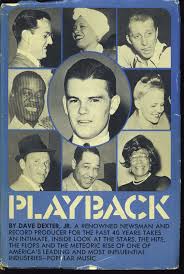 Capitol Records president Alan Livingston assigned the task of screening British EMI recordings for possible release in the US to Dave Dexter Jr. "Dave was a good musicologist and he was a writer and producer," recalled Alan Livingston, "and I trusted Dave's ears and was not concerned about it." Dave Dexter, unfortunately, wasn't impressed at all by the first two Beatles singles that came across his desk. The main reason for his rejection of both "Love Me Do" and "Please Please Me" was the group's prominent use of the harmonica, which he viewed as a "blues" instrument that had no place in pop music. Capitol Records president Alan Livingston assigned the task of screening British EMI recordings for possible release in the US to Dave Dexter Jr. "Dave was a good musicologist and he was a writer and producer," recalled Alan Livingston, "and I trusted Dave's ears and was not concerned about it." Dave Dexter, unfortunately, wasn't impressed at all by the first two Beatles singles that came across his desk. The main reason for his rejection of both "Love Me Do" and "Please Please Me" was the group's prominent use of the harmonica, which he viewed as a "blues" instrument that had no place in pop music.
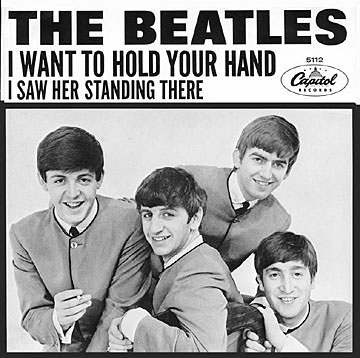 Possibly because of Capitol's negative view of the harmonica, The Beatles shied away from featuring the instrument on their singles in order to appease the US market. When Capitol Records eventually became coerced into signing the band to their label and released their newest single "I Want To Hold Your Hand," there was not a harmonica in sight. Possibly because of Capitol's negative view of the harmonica, The Beatles shied away from featuring the instrument on their singles in order to appease the US market. When Capitol Records eventually became coerced into signing the band to their label and released their newest single "I Want To Hold Your Hand," there was not a harmonica in sight.
What the label couldn't have predicted back then is how The Beatles would turn the American music industry on its ear and become a huge "cash-cow" for them just over a year later. The tide had definitely turned and Capitol would embrace whatever The Beatles wanted to throw their way.
 An example of the "about-face" attitude the US label adopted was concerning the Beatles song "I Should Have Known Better." With the release of their third Capitol single "A Hard Day's Night," they decided that they did not want to issue the b-side Parlophone Records used for the British release, which was the somewhat downbeat song "Things We Said Today." With the intention of promoting their upcoming film, Capitol wanted to place a song from its soundtrack on the b-side of this new single. Of the five possible choices, they picked one that prominently featured John Lennon puffing that same "blues" instrument. I guess the harmonica did have a place in pop music after all. An example of the "about-face" attitude the US label adopted was concerning the Beatles song "I Should Have Known Better." With the release of their third Capitol single "A Hard Day's Night," they decided that they did not want to issue the b-side Parlophone Records used for the British release, which was the somewhat downbeat song "Things We Said Today." With the intention of promoting their upcoming film, Capitol wanted to place a song from its soundtrack on the b-side of this new single. Of the five possible choices, they picked one that prominently featured John Lennon puffing that same "blues" instrument. I guess the harmonica did have a place in pop music after all.
Songwriting History
 "One of the most memorable things of the trip (to Paris) for me," George remembered, "was that we had a copy of Bob Dylan's 'Freewheelin'' album, which we played constantly." Their three week performance season at the Olympia Theatre in Paris, France, had them held up in the luxuriant George V Hotel from January 15th through February 4th, 1964. Between concerts, they had a piano brought in specifically for them to start writing songs for their first motion picture, which they were set to begin shooting on March 2nd. When they weren't songwriting, they were listening to their newly acquired Bob Dylan album. "One of the most memorable things of the trip (to Paris) for me," George remembered, "was that we had a copy of Bob Dylan's 'Freewheelin'' album, which we played constantly." Their three week performance season at the Olympia Theatre in Paris, France, had them held up in the luxuriant George V Hotel from January 15th through February 4th, 1964. Between concerts, they had a piano brought in specifically for them to start writing songs for their first motion picture, which they were set to begin shooting on March 2nd. When they weren't songwriting, they were listening to their newly acquired Bob Dylan album.
 "I think that was the first time I ever heard (Bob) Dylan at all," John remembered in 1970. "I think Paul got the record from a French DJ. We were doing a radio thing there and the guy had the record in the studio. Paul said, 'Oh yeah, I keep hearing about this guy,' or he'd heard it, I'm not sure - and we took it back to the (Georve V) Hotel." Lennon stated in 1964, "And for the rest of our three weeks in Paris, we didn't stop playing it. We all went potty on (Bob) Dylan." "I think that was the first time I ever heard (Bob) Dylan at all," John remembered in 1970. "I think Paul got the record from a French DJ. We were doing a radio thing there and the guy had the record in the studio. Paul said, 'Oh yeah, I keep hearing about this guy,' or he'd heard it, I'm not sure - and we took it back to the (Georve V) Hotel." Lennon stated in 1964, "And for the rest of our three weeks in Paris, we didn't stop playing it. We all went potty on (Bob) Dylan."
 Although the harmonica was beginning to take a back-seat for The Beatles in the studio (last used on September 12th, 1963 when they recorded "Little Child"), Lennon found a new use for the harmonica as inspired by Bob Dylan. His 'huffing/puffing' folk style of harmonica playing got John writing a song around this style. While Lennon had been using the harmonica (or "harp" as he was prone to call it) as more of a blues instrument, he now appears to have put that aside forever. Although the harmonica was beginning to take a back-seat for The Beatles in the studio (last used on September 12th, 1963 when they recorded "Little Child"), Lennon found a new use for the harmonica as inspired by Bob Dylan. His 'huffing/puffing' folk style of harmonica playing got John writing a song around this style. While Lennon had been using the harmonica (or "harp" as he was prone to call it) as more of a blues instrument, he now appears to have put that aside forever.
 He now began to recast himself as a folk musician in the style of his new-found hero. When, during their February 1964 visit to New York City, more upbeat songs were requested to be written for their first movie, Lennon penned "I Should Have Known Better" under Bob Dylan's influence. He even started wearing a Bob Dylan-style hat during this period (as seen in the "A Hard Day's Night" movie and on the cover of his book "In His Own Write"), and eventually using a harmonica brace during concert performances of the Bob Dylan-inspired "I'm A Loser." He now began to recast himself as a folk musician in the style of his new-found hero. When, during their February 1964 visit to New York City, more upbeat songs were requested to be written for their first movie, Lennon penned "I Should Have Known Better" under Bob Dylan's influence. He even started wearing a Bob Dylan-style hat during this period (as seen in the "A Hard Day's Night" movie and on the cover of his book "In His Own Write"), and eventually using a harmonica brace during concert performances of the Bob Dylan-inspired "I'm A Loser."
 In January of 1964, this was the extent of John's Bob Dylan influence. Lyrically, "I Should Have Known Better" stays remarkably close to the cliché-heavy romanticism of earlier Lennon / McCartney songs. "Just a song - it doesn't mean a damn thing," Lennon remarked in 1980. It wasn't until later, after The Beatles actually got to spend time with Bob Dylan on different occasions, that John saw fit to express himself lyrically in a more emotive and therapeutic way (such as in "Help!"). Musically, the Bob Dylan influence manifested as well, such as with "You've Got To Hide Your Love Away." But for now, the harmonica was as far as Lennon got. In January of 1964, this was the extent of John's Bob Dylan influence. Lyrically, "I Should Have Known Better" stays remarkably close to the cliché-heavy romanticism of earlier Lennon / McCartney songs. "Just a song - it doesn't mean a damn thing," Lennon remarked in 1980. It wasn't until later, after The Beatles actually got to spend time with Bob Dylan on different occasions, that John saw fit to express himself lyrically in a more emotive and therapeutic way (such as in "Help!"). Musically, the Bob Dylan influence manifested as well, such as with "You've Got To Hide Your Love Away." But for now, the harmonica was as far as Lennon got.
 One fact that hasn't been contested is that the song "I Should Have Known Better" was written entirely by Lennon. "That's me," John stated about the song in 1980. His authorship is very apparent, especially the "one-note" melody line of the verses, which is witnessed quite a lot throughout his output during the Beatle years. Examples of this are the verses in "Help!" and the bridge in "Girl." One fact that hasn't been contested is that the song "I Should Have Known Better" was written entirely by Lennon. "That's me," John stated about the song in 1980. His authorship is very apparent, especially the "one-note" melody line of the verses, which is witnessed quite a lot throughout his output during the Beatle years. Examples of this are the verses in "Help!" and the bridge in "Girl."
Recording History
 As soon as The Beatles got back from their first historic visit to America in February of 1964, they commenced recording songs for their upcoming movie. February 25th was their first of four days of recording sessions booked in EMI Studio Two for recording the songs that would be featured in the film. Two sessions were booked on this day, the first used to finish off "Can't Buy Me Love" and then fully record the Lennon song "You Can't Do That," which finalized their next international hit single. As soon as The Beatles got back from their first historic visit to America in February of 1964, they commenced recording songs for their upcoming movie. February 25th was their first of four days of recording sessions booked in EMI Studio Two for recording the songs that would be featured in the film. Two sessions were booked on this day, the first used to finish off "Can't Buy Me Love" and then fully record the Lennon song "You Can't Do That," which finalized their next international hit single.
 The second session this day, which ran from 2:30 to 5:30 pm, premiered two more songs for the film, namely "And I Love Her" and "I Should Have Known Better." Unfortunately, this afternoon/evening session did not see either of these songs to completion, nor were any takes of these recordings used for the final releases. Both songs were started again from scratch the next day. The second session this day, which ran from 2:30 to 5:30 pm, premiered two more songs for the film, namely "And I Love Her" and "I Should Have Known Better." Unfortunately, this afternoon/evening session did not see either of these songs to completion, nor were any takes of these recordings used for the final releases. Both songs were started again from scratch the next day.
 Only three takes of "I Should Have Known Better" were recorded at this session, and only one of these takes was complete. The second take itself only lasted seconds as John broke down laughing because of his harmonica playing. One thing that should be mentioned is that the song sounded somewhat different at this stage, beginning with an even more Bob Dylan-ish harmonica introduction as well as some guitar work from George Harrison at the end of the song. As 5:30 rolled around, they decided they would start it again fresh the next day. Only three takes of "I Should Have Known Better" were recorded at this session, and only one of these takes was complete. The second take itself only lasted seconds as John broke down laughing because of his harmonica playing. One thing that should be mentioned is that the song sounded somewhat different at this stage, beginning with an even more Bob Dylan-ish harmonica introduction as well as some guitar work from George Harrison at the end of the song. As 5:30 rolled around, they decided they would start it again fresh the next day.
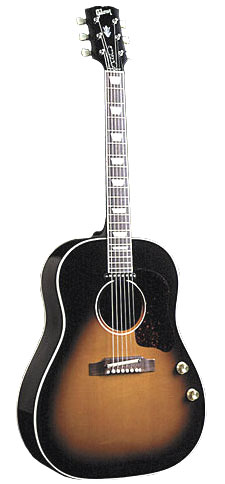 The band returned to Studio Two the next day, February 26th, at the same time, 2:30 to 5:30 pm, and devoted the entire three hour session to re-recording the song. The problem area was the bridge, where most of the 19 takes of the song performed on this day broke down. For the first five takes ("take four" through "take eight" to indicate the three takes they made the previous day) they played all their usual instruments except for John, who sang and played harmonica only. On "take nine" John decided to play his Gibson J160E acoustic guitar instead of harmonica for the first time. This ended up being the final take, although The Beatles continued to improve upon it until it became "take 22," onto which John double-tracked his vocals and overdubbed his harmonica. This allowed segments of the song to include both John's vocals and harmonica playing at the same time. The band returned to Studio Two the next day, February 26th, at the same time, 2:30 to 5:30 pm, and devoted the entire three hour session to re-recording the song. The problem area was the bridge, where most of the 19 takes of the song performed on this day broke down. For the first five takes ("take four" through "take eight" to indicate the three takes they made the previous day) they played all their usual instruments except for John, who sang and played harmonica only. On "take nine" John decided to play his Gibson J160E acoustic guitar instead of harmonica for the first time. This ended up being the final take, although The Beatles continued to improve upon it until it became "take 22," onto which John double-tracked his vocals and overdubbed his harmonica. This allowed segments of the song to include both John's vocals and harmonica playing at the same time.
 There was, however, one overdub they attempted that they decided not to use. A 16-year-old Ken Scott (future Beatles engineer) had just been hired to work in the tape library at EMI a month earlier and had wormed his way into an actual Beatles recording session. In his book "Abbey Road To Ziggy Stardust," he relates about getting acquainted with Beatles' engineer Norman Smith. "I amazed myself by being very up front and asked him if there was any chance of me poking my head in the door so I could watch (The Beatles) record for a bit. He hesitated for a second, then told me, 'Yes, but keep to the back and don't let anyone notice you're there. They can be a bit touchy about new people, so just be a part of the furniture.' Well, of course a cocky 16-year-old couldn't stop there. 'Maybe I could take some pictures?' I asked, assuming I would never get this opportunity again. 'Don't make it obvious,' Norman (Smith) warned." There was, however, one overdub they attempted that they decided not to use. A 16-year-old Ken Scott (future Beatles engineer) had just been hired to work in the tape library at EMI a month earlier and had wormed his way into an actual Beatles recording session. In his book "Abbey Road To Ziggy Stardust," he relates about getting acquainted with Beatles' engineer Norman Smith. "I amazed myself by being very up front and asked him if there was any chance of me poking my head in the door so I could watch (The Beatles) record for a bit. He hesitated for a second, then told me, 'Yes, but keep to the back and don't let anyone notice you're there. They can be a bit touchy about new people, so just be a part of the furniture.' Well, of course a cocky 16-year-old couldn't stop there. 'Maybe I could take some pictures?' I asked, assuming I would never get this opportunity again. 'Don't make it obvious,' Norman (Smith) warned."
 Ken Scott continues: "Come the day and I have this cheap old camera in my hand, and whilst watching the session, I started to take some pictures...After a while The Beatles decided they wanted to try some handclaps on a song and said to the room, 'Come on. Everyone down to join in.' I looked over at Norman (Smith) and he looked over at me and sort of nodded his head to let me know it was OK to do it. 'Blimey, I'm gonna go down and clap with The Beatles,' I thought. Could it ever get any better than this? There were eight or nine of us, including Ringo and Paul, gathered around the mic clapping along to 'I Should Have Known Better.' After the take, the two of them went upstairs (to the control room) while the rest of us stayed there looking up at the glass waiting for a decision, then someone came out to the top of the stairs and yelled, 'It doesn't work so forget it. Just come back up here.'" Ken Scott continues: "Come the day and I have this cheap old camera in my hand, and whilst watching the session, I started to take some pictures...After a while The Beatles decided they wanted to try some handclaps on a song and said to the room, 'Come on. Everyone down to join in.' I looked over at Norman (Smith) and he looked over at me and sort of nodded his head to let me know it was OK to do it. 'Blimey, I'm gonna go down and clap with The Beatles,' I thought. Could it ever get any better than this? There were eight or nine of us, including Ringo and Paul, gathered around the mic clapping along to 'I Should Have Known Better.' After the take, the two of them went upstairs (to the control room) while the rest of us stayed there looking up at the glass waiting for a decision, then someone came out to the top of the stairs and yelled, 'It doesn't work so forget it. Just come back up here.'"
 "The moment that I set foot in the control room, (producer) George Martin came up to me and politely asked, 'Excuse me, but who are you?' Caught off guard, I sputtered, 'Mr. Martin, sir, I just started up in the tape library a couple of weeks ago...' and George (Martin) immediately stopped me mid-sentence and said rather sternly, 'Get out!' I thought to myself, 'Oh, hell. This is it. I'm going to get fired,' but at least I'd had a chance to be in the studio with The Beatles. Did anything else really matter? I had heard nothing about getting fired, and a couple of days later George Martin came up to the tape library and asked me, 'So how did the pictures turn out?'" "The moment that I set foot in the control room, (producer) George Martin came up to me and politely asked, 'Excuse me, but who are you?' Caught off guard, I sputtered, 'Mr. Martin, sir, I just started up in the tape library a couple of weeks ago...' and George (Martin) immediately stopped me mid-sentence and said rather sternly, 'Get out!' I thought to myself, 'Oh, hell. This is it. I'm going to get fired,' but at least I'd had a chance to be in the studio with The Beatles. Did anything else really matter? I had heard nothing about getting fired, and a couple of days later George Martin came up to the tape library and asked me, 'So how did the pictures turn out?'"
 March 3rd, 1964 was when the official mono mix of the song was created in the EMI Studio One control room. What was now considered "take 22" was used for this mix, which was made by George Martin and engineers Norman Smith and A.B. Lincoln. This mix, along with five other songs, was sent to United Artists for them to use in the production of the movie. An edit was also made to "I Should Have Known Better" on this day concerning the harmonica heard in its introduction. The fourth measure of the four measure introduction showed John taking a needed breath, which created a gap in his harmonica playing. In order to fix the gap, they grafted in a repeat of the third measure to replace the fourth measure. This made it appear that he played the harmonica uninterrupted for four straight measures. March 3rd, 1964 was when the official mono mix of the song was created in the EMI Studio One control room. What was now considered "take 22" was used for this mix, which was made by George Martin and engineers Norman Smith and A.B. Lincoln. This mix, along with five other songs, was sent to United Artists for them to use in the production of the movie. An edit was also made to "I Should Have Known Better" on this day concerning the harmonica heard in its introduction. The fourth measure of the four measure introduction showed John taking a needed breath, which created a gap in his harmonica playing. In order to fix the gap, they grafted in a repeat of the third measure to replace the fourth measure. This made it appear that he played the harmonica uninterrupted for four straight measures.
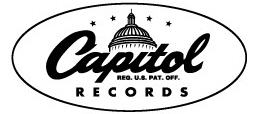 On June 9th, 1964, George Martin with engineers Norman Smith and Ken Scott all convened in the EMI Studio Three control rrom to make copies of the previous mono mix of the song to be sent to United Artists Records and Capitol Records in the US. This mono mix was used by United Artists for both the mono and stereo soundtrack album and by Capitol for the b-side of the upcoming "A Hard Day's Night" single. On June 9th, 1964, George Martin with engineers Norman Smith and Ken Scott all convened in the EMI Studio Three control rrom to make copies of the previous mono mix of the song to be sent to United Artists Records and Capitol Records in the US. This mono mix was used by United Artists for both the mono and stereo soundtrack album and by Capitol for the b-side of the upcoming "A Hard Day's Night" single.
 June 22nd, 1964, was when EMI studio personnel finally created the first stereo mix of "I Should Have Known Better." This long session, which ran from 10 am to 9 pm in the EMI Studio One control room, saw the entire contents of the UK "A Hard Day's Night" album mixed for stereo, as well as some additional mono mixing and editing work. At about noon at this session, George Martin, Norman Smith and 2nd engineer Geoff Emerick made the stereo mix of the song. June 22nd, 1964, was when EMI studio personnel finally created the first stereo mix of "I Should Have Known Better." This long session, which ran from 10 am to 9 pm in the EMI Studio One control room, saw the entire contents of the UK "A Hard Day's Night" album mixed for stereo, as well as some additional mono mixing and editing work. At about noon at this session, George Martin, Norman Smith and 2nd engineer Geoff Emerick made the stereo mix of the song.
 Because of the rushed atmosphere of this day, and also because they all held stereo mixing in such low regard, they didn't take the time to graft in the third measure of the introduction into the fourth measure. Therefore, the stereo mix most generally known throughout the years included the gap in John's harmonica playing towards the end of the introduction. Not a major blemish by any means, but a noticeable difference nonetheless. Because of the rushed atmosphere of this day, and also because they all held stereo mixing in such low regard, they didn't take the time to graft in the third measure of the introduction into the fourth measure. Therefore, the stereo mix most generally known throughout the years included the gap in John's harmonica playing towards the end of the introduction. Not a major blemish by any means, but a noticeable difference nonetheless.
 Another noticeable difference witnessed in this stereo mix is an edit in the rhythm track during the final bridge. This occurs just before the words “and when I ask you to be mine” and can be witnessed distinctly in the left channel. Incidentally, John's harmonica work and Harrison's 12-string guitar strums in the bridges as well as the guitar solo are mostly heard in the right channel while the rhythm track (drums, acoustic guitars and bass) is heard mostly in the left channel. All of the vocals are centered in the mix. Another noticeable difference witnessed in this stereo mix is an edit in the rhythm track during the final bridge. This occurs just before the words “and when I ask you to be mine” and can be witnessed distinctly in the left channel. Incidentally, John's harmonica work and Harrison's 12-string guitar strums in the bridges as well as the guitar solo are mostly heard in the right channel while the rhythm track (drums, acoustic guitars and bass) is heard mostly in the left channel. All of the vocals are centered in the mix.
 The Beatles recorded this song twice more, these being made specifically for BBC radio. The first was on July 14th, 1964 in Studios B7/S2 of Broadcasting House in London between 7 and 11 pm for the first installment of a new BBC radio show called "Top Gear," which was produced by Bernie Andrews and broadcast on July 16th between 10 and 11:55 pm. The second BBC recording of the song was done on July 17th, 1964 at BBC Paris Studio in London between 2:15 and 6:15 pm for the fourth installment of their radio show "From Us To You," this song being produced by Bryant Marriott and broadcast on August 3rd beteen 10 am and 12 noon. The Beatles recorded this song twice more, these being made specifically for BBC radio. The first was on July 14th, 1964 in Studios B7/S2 of Broadcasting House in London between 7 and 11 pm for the first installment of a new BBC radio show called "Top Gear," which was produced by Bernie Andrews and broadcast on July 16th between 10 and 11:55 pm. The second BBC recording of the song was done on July 17th, 1964 at BBC Paris Studio in London between 2:15 and 6:15 pm for the fourth installment of their radio show "From Us To You," this song being produced by Bryant Marriott and broadcast on August 3rd beteen 10 am and 12 noon.
 One other stereo mix of this song was created, but not until early in 1982. A mixing session was booked at this time to finally create a stereo mix of the song without the harmonica gap in the intro. This mix was created primarily for the 1982 album "Reel Music." The noticeable difference here, though, is that this new stereo mix grafted in a repeat of the second measure instead of the third measure as appearing in the original mono mix. The harmonica playing was a little different in these measures, true Beatlemaniacs noting this difference. One other stereo mix of this song was created, but not until early in 1982. A mixing session was booked at this time to finally create a stereo mix of the song without the harmonica gap in the intro. This mix was created primarily for the 1982 album "Reel Music." The noticeable difference here, though, is that this new stereo mix grafted in a repeat of the second measure instead of the third measure as appearing in the original mono mix. The harmonica playing was a little different in these measures, true Beatlemaniacs noting this difference.
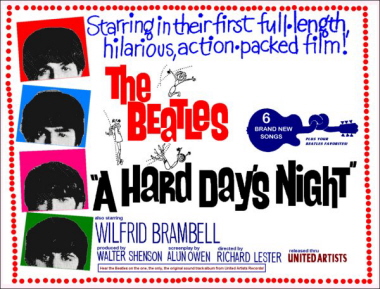 It is also interesting to notice that releases of the "A Hard Day's Night" movie in later decades contain this newly-created stereo mix of this track when it first appears in the film (in the train scene). The first stereo mix of the song with John's harmonica gap is later used for its second appearance in the movie (in the TV show scene). It is also interesting to notice that releases of the "A Hard Day's Night" movie in later decades contain this newly-created stereo mix of this track when it first appears in the film (in the train scene). The first stereo mix of the song with John's harmonica gap is later used for its second appearance in the movie (in the TV show scene).
Song Structure and Style
 Once again, Lennon takes a standard songwriting structure and adds in a few unique elements to make the song stand alone. The primary component is the verse, which propels it throughout. The bridge, which is repeated twice, acts as the emotive climax with its Beatles trademark jump to falsetto. The structure they present is 'verse/ alternate verse/ bridge/ verse/ instrumental verse/ alternate verse/ bridge' (described here as abcaabc). Once again, Lennon takes a standard songwriting structure and adds in a few unique elements to make the song stand alone. The primary component is the verse, which propels it throughout. The bridge, which is repeated twice, acts as the emotive climax with its Beatles trademark jump to falsetto. The structure they present is 'verse/ alternate verse/ bridge/ verse/ instrumental verse/ alternate verse/ bridge' (described here as abcaabc).
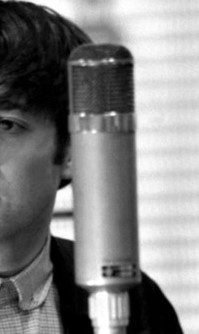 We start out with a four measure intro to this last Beatles song that features harmonica at the beginning. John's voice heralds in the first verse which, as all the verses do, holds out the first 1 1/2 measures on one note, which is always on the lyric "I." In fact, this is the only time the song's title is witnessed in the song. This verse is ten measures long, extending the expected eight measures by an insertion of two measures in the middle, which repeat the previously heard melody line ("that I would love everything that you do"). The single-note and fast-paced melody line that is held throughout the track drives upward with the purpose of climactically concluding the verse. We start out with a four measure intro to this last Beatles song that features harmonica at the beginning. John's voice heralds in the first verse which, as all the verses do, holds out the first 1 1/2 measures on one note, which is always on the lyric "I." In fact, this is the only time the song's title is witnessed in the song. This verse is ten measures long, extending the expected eight measures by an insertion of two measures in the middle, which repeat the previously heard melody line ("that I would love everything that you do"). The single-note and fast-paced melody line that is held throughout the track drives upward with the purpose of climactically concluding the verse.
 A second verse then appears, this one being developed structurally the same as the first, but is in fact only eight measures long and is used as a transition into the bridge that immediately follows afterward. Since this transitory bridge is also repeated when the bridge is repeated, we'll give this the designation of 'alternate verse.' A second verse then appears, this one being developed structurally the same as the first, but is in fact only eight measures long and is used as a transition into the bridge that immediately follows afterward. Since this transitory bridge is also repeated when the bridge is repeated, we'll give this the designation of 'alternate verse.'
 This song's bridge is sixteen measures long and made up primarily of quarter-notes, emphasizing the importance of the lyrics, making teenage girls blush as John Lennon confesses his love for them. (Actress Pattie Boyd hides her eyes embarrassingly at this point of the song in the film.) Even the double-tracking of his vocal disappears for most of this verse, adding an intimate touch. After the falsetto jump of the twelfth measure we land back in the home key for the perfect resolve. This song's bridge is sixteen measures long and made up primarily of quarter-notes, emphasizing the importance of the lyrics, making teenage girls blush as John Lennon confesses his love for them. (Actress Pattie Boyd hides her eyes embarrassingly at this point of the song in the film.) Even the double-tracking of his vocal disappears for most of this verse, adding an intimate touch. After the falsetto jump of the twelfth measure we land back in the home key for the perfect resolve.
 After another structurally identical verse, the ten measure verse pattern is repeated once more as an instrumental section, which presents a solo played on George Harrison's newly acquired Rickenbacker 360-12-string. We then hear again the alternate verse and bridge to round out the song, complete with a faded-out conclusion echoing the opening moments of the song with the addition of the repeated last phrase "you love me too." After another structurally identical verse, the ten measure verse pattern is repeated once more as an instrumental section, which presents a solo played on George Harrison's newly acquired Rickenbacker 360-12-string. We then hear again the alternate verse and bridge to round out the song, complete with a faded-out conclusion echoing the opening moments of the song with the addition of the repeated last phrase "you love me too."
Lyrically the song does not say very much, but accomplishes its purpose exceptionally well, be it ever so naïve. The lead singer "should have known" that he would fall in love with the girl in question because of all the things she does, which apparently includes kissing. John touches once again on the "law of attraction" philosophy, stating with complete confidence that when he expresses his love for the girl, "you're gonna say you love me too." He isn't hoping; he knows!
 John's Bob Dylan-like harmonica work, which ended up a little "bluesy" after all, is truly the highlight of the song. That, and of course, his convincing vocal delivery which pumped an effervescent quality into The Beatles of 1964. While his rhythm guitar work may have been rudimentary, it suited the Dylan-esque "singer-songwriter" persona he was trying to achieve. John's Bob Dylan-like harmonica work, which ended up a little "bluesy" after all, is truly the highlight of the song. That, and of course, his convincing vocal delivery which pumped an effervescent quality into The Beatles of 1964. While his rhythm guitar work may have been rudimentary, it suited the Dylan-esque "singer-songwriter" persona he was trying to achieve.
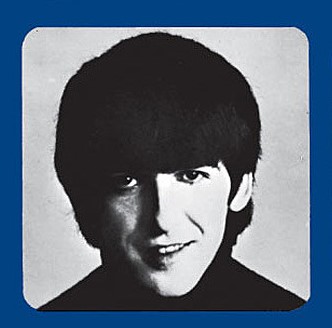 George Harrison is next to be mentioned for his simple but effective guitar solo, keeping strictly to the melody line with limited embellishments. A nice feature also heard from George is the guitar strums at the beginning of each measure of the bridge in order to initiate each chord change. This well thought-out addition dispensed with any "clunkiness" that may have crept in to muddy up the arrangement. Well done. George Harrison is next to be mentioned for his simple but effective guitar solo, keeping strictly to the melody line with limited embellishments. A nice feature also heard from George is the guitar strums at the beginning of each measure of the bridge in order to initiate each chord change. This well thought-out addition dispensed with any "clunkiness" that may have crept in to muddy up the arrangement. Well done.
 McCartney takes a comfortable back seat on this song vocally, letting John sing this intimate song by himself while providing some well-rehearsed bass runs which are subdued enough not to be too intrusive for this simple arrangement. Paul's presence here suits the song well. McCartney takes a comfortable back seat on this song vocally, letting John sing this intimate song by himself while providing some well-rehearsed bass runs which are subdued enough not to be too intrusive for this simple arrangement. Paul's presence here suits the song well.
Ringo plays the role of metronome throughout, doing little more than keeping a steady beat, which is all that the song calls for. The listener can hear him showing his chops elsewhere on the album, such as on "Tell Me Why."
American Releases
 America first heard "I Should Have Known Better" on the highly-anticipated soundtrack album to their first movie "A Hard Day's Night" released by United Artists on June 26th, 1964. This album was rush-released to make sure Capitol Records didn't grab all the attention with their soon to be released album "Something New," which was also to include the song. Since United Artists got their album out first, Capitol decided not to include a few of the soundtrack songs on their album, this being one of them. America first heard "I Should Have Known Better" on the highly-anticipated soundtrack album to their first movie "A Hard Day's Night" released by United Artists on June 26th, 1964. This album was rush-released to make sure Capitol Records didn't grab all the attention with their soon to be released album "Something New," which was also to include the song. Since United Artists got their album out first, Capitol decided not to include a few of the soundtrack songs on their album, this being one of them.
 Since United Artists only had the mono masters they received around June 10th, 1964 to work with, and they were anxious to release their album as soon as possible, the label created a "High Fidelity Stereo" mix of the song for the stereo relese of their album using this mix. After transferring the mono master to two seperate channels by boosting the bass in the left channel and raising the treble in the right channel, they raised the volume of the guitar solo in the right channel to create an illusion of stereo. United Artists kept this album in print until the label was purchased by Capitol Records in 1978, Capitol beginning their reprints of this soundtrack album on August 1st, 1980. This American sountrack album got its compact disc release on January 21st, 2014, both the mono and stereo versions of the album being contained on a single CD. Since United Artists only had the mono masters they received around June 10th, 1964 to work with, and they were anxious to release their album as soon as possible, the label created a "High Fidelity Stereo" mix of the song for the stereo relese of their album using this mix. After transferring the mono master to two seperate channels by boosting the bass in the left channel and raising the treble in the right channel, they raised the volume of the guitar solo in the right channel to create an illusion of stereo. United Artists kept this album in print until the label was purchased by Capitol Records in 1978, Capitol beginning their reprints of this soundtrack album on August 1st, 1980. This American sountrack album got its compact disc release on January 21st, 2014, both the mono and stereo versions of the album being contained on a single CD.
 On July 13th, 1964, Capitol released their "A Hard Day's Night" single and, with the intention of promoting the film for their own benefit, decided to position "I Should Have Known Better" as the b-side. This was the second and last time that Capitol chose a different song as the b-side for a single than what was issued in Britain, which happened to be the non-soundtrack song "Things We Said Today." As a b-side, "I Should Have Known Better" placed on its own at #53 on the Billboard Hot 100. On July 13th, 1964, Capitol released their "A Hard Day's Night" single and, with the intention of promoting the film for their own benefit, decided to position "I Should Have Known Better" as the b-side. This was the second and last time that Capitol chose a different song as the b-side for a single than what was issued in Britain, which happened to be the non-soundtrack song "Things We Said Today." As a b-side, "I Should Have Known Better" placed on its own at #53 on the Billboard Hot 100.
 Sometime during 1967, United Artists Records released a unique version of the "A Hard Day's Night" soundtrack LP on the new but short-lived format "Playtapes." These tapes did not contain the capability of including entire LP's, so a truncated eight-song version of the album was released in this portable format, "I Should Have Known Better" being one of these songs. These "Playtapes" are somewhat hard to find and quite collectable today. Sometime during 1967, United Artists Records released a unique version of the "A Hard Day's Night" soundtrack LP on the new but short-lived format "Playtapes." These tapes did not contain the capability of including entire LP's, so a truncated eight-song version of the album was released in this portable format, "I Should Have Known Better" being one of these songs. These "Playtapes" are somewhat hard to find and quite collectable today.
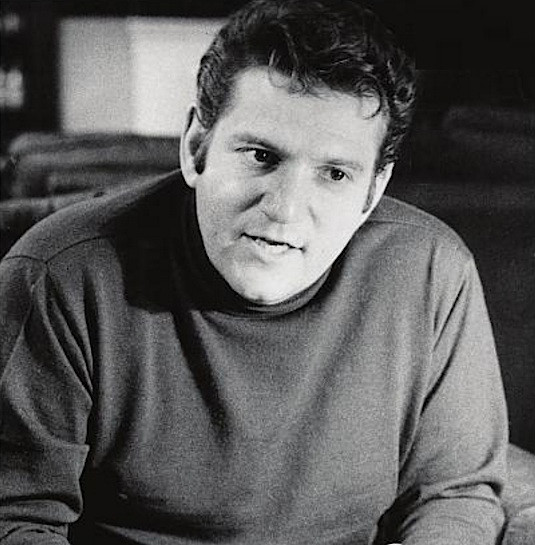 "I Should Have Known Better" had not been heard in true stereo in the US throughout the '60s, being that the United Artists soundtrack album placed the mono mix on the stereo copies of the album. But on February 26th, 1970, Apple Records made it right. Allen Klein, The Beatles' new manager, was anxious to have another Beatles album on the market in America since he just negotiated a very lucrative new contract for the band. The result was an album entitled "The Beatles Again." "I Should Have Known Better" had not been heard in true stereo in the US throughout the '60s, being that the United Artists soundtrack album placed the mono mix on the stereo copies of the album. But on February 26th, 1970, Apple Records made it right. Allen Klein, The Beatles' new manager, was anxious to have another Beatles album on the market in America since he just negotiated a very lucrative new contract for the band. The result was an album entitled "The Beatles Again."
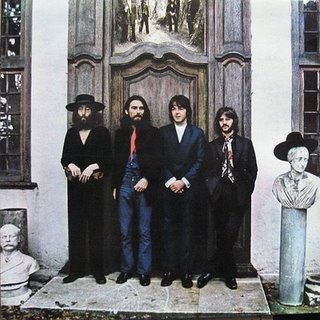 Although the album didn't include any songs that were new to the US audience, it pulled together songs that spanned the entire Beatles catalog that were not released on a Capitol album as of yet. Since "I Should Have Known Better" fit the bill, the original stereo mix was included here. After the initial run was printed, the decision was made to re-title the album "Hey Jude," which was the title printed on the album cover. Hot on the heels of the highly successful "Abbey Road" album, American fans bought this album in droves, and it ended up peaking at #2 on the Billboard album chart for four weeks. The "Hey Jude" album received a compact disc release on January 21st, 2014. Although the album didn't include any songs that were new to the US audience, it pulled together songs that spanned the entire Beatles catalog that were not released on a Capitol album as of yet. Since "I Should Have Known Better" fit the bill, the original stereo mix was included here. After the initial run was printed, the decision was made to re-title the album "Hey Jude," which was the title printed on the album cover. Hot on the heels of the highly successful "Abbey Road" album, American fans bought this album in droves, and it ended up peaking at #2 on the Billboard album chart for four weeks. The "Hey Jude" album received a compact disc release on January 21st, 2014.
 The song didn't get another release until March 22nd, 1982, on the compilation album "Reel Music." The premise of this album was to put together the highlights of all the songs from the Beatles films. The album did well enough to make it to #19 on the Billboard album chart. Over 12,000 promo copies of this album were also printed, these being on translucent gold vinyl. Not only did "I Should Have Known Better" make it onto the album, but a segment of the song even appeared in "The Beatles Movie Medley," which was a #12 hit single on the Billboard Hot 100 that comprised snippets of seven songs from the "Reel Music" album. The song didn't get another release until March 22nd, 1982, on the compilation album "Reel Music." The premise of this album was to put together the highlights of all the songs from the Beatles films. The album did well enough to make it to #19 on the Billboard album chart. Over 12,000 promo copies of this album were also printed, these being on translucent gold vinyl. Not only did "I Should Have Known Better" make it onto the album, but a segment of the song even appeared in "The Beatles Movie Medley," which was a #12 hit single on the Billboard Hot 100 that comprised snippets of seven songs from the "Reel Music" album.
 This single was also included in the vinyl box set "The Beatles Singles Collection" that was released in the US on December 6th, 1982. Also included in this box set was a single that was released in the UK in February of 1976, this being "Yesterday" with "I Should Have Known Better" as its b-side. This was the only time this unique single was commercially available in the US since it was dropped from future reissues of this box set. This single was also included in the vinyl box set "The Beatles Singles Collection" that was released in the US on December 6th, 1982. Also included in this box set was a single that was released in the UK in February of 1976, this being "Yesterday" with "I Should Have Known Better" as its b-side. This was the only time this unique single was commercially available in the US since it was dropped from future reissues of this box set.
 The first time that the original British "A Hard Day's Night" album was made available in America was on the "Original Master Recording" vinyl edition released through Mobile Fidelity Sound Lab in February of 1987. This album included "I Should Have Known Better" and was prepared utilizing half-speed mastering technology from the original master tape on loan from EMI. This version of the album was only available for a short time and is quite collectible today. The first time that the original British "A Hard Day's Night" album was made available in America was on the "Original Master Recording" vinyl edition released through Mobile Fidelity Sound Lab in February of 1987. This album included "I Should Have Known Better" and was prepared utilizing half-speed mastering technology from the original master tape on loan from EMI. This version of the album was only available for a short time and is quite collectible today.
 February 26th, 1987 was the date that the original British "A Hard Day's Night" album was released in America in the compact disc format, a vinyl edition coming out on July 21st, 1987. While this album was only available then in mono, the remastered stereo version was released on CD on September 9th, 2009 and on vinyl on November 13th, 2012. February 26th, 1987 was the date that the original British "A Hard Day's Night" album was released in America in the compact disc format, a vinyl edition coming out on July 21st, 1987. While this album was only available then in mono, the remastered stereo version was released on CD on September 9th, 2009 and on vinyl on November 13th, 2012.
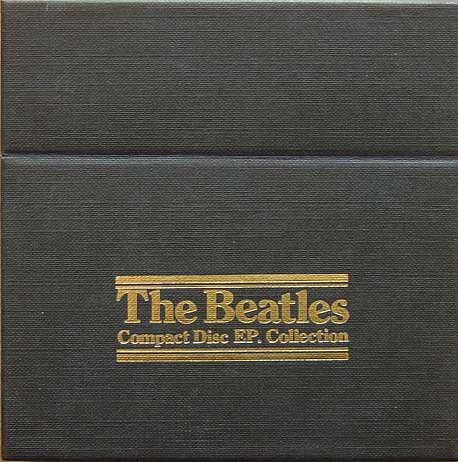 Back on June 30th, 1992, Capitol Records released a CD box set entitled “Compact Disc EP Collection” which contained the mono mix of “I Should Have Known Better” because of the song's initial inclusion on the original British EP “Extracts From The Film A Hard Day's Night.” Back on June 30th, 1992, Capitol Records released a CD box set entitled “Compact Disc EP Collection” which contained the mono mix of “I Should Have Known Better” because of the song's initial inclusion on the original British EP “Extracts From The Film A Hard Day's Night.”
 The 1964 mono mix of "I Should Have Known Better" was also remastered and made available on the box set "The Beatles In Mono," which was released on CD on September 9th, 2009 and on vinyl on September 9th, 2014. The 1964 mono mix of "I Should Have Known Better" was also remastered and made available on the box set "The Beatles In Mono," which was released on CD on September 9th, 2009 and on vinyl on September 9th, 2014.
Live Performances
The Beatles gave the song a short British performance life in 1964, starting just after the "A Hard Day's Night" album was released there with a pair of BBC radio shows, as detailed under "Recording History."
 Their British tour of late 1964, which ran from October 9th in Bradford to November 10th in Bristol, included the song as well. The band also mimed a performance for British TV on October 14th, which was broadcast on "Scene At 6:30" on October 16th. By the time the end of the year rolled around their use for the song faded away as The Beatles began focusing instead on newly recorded songs for their British "Beatles For Sale" album. Their British tour of late 1964, which ran from October 9th in Bradford to November 10th in Bristol, included the song as well. The band also mimed a performance for British TV on October 14th, which was broadcast on "Scene At 6:30" on October 16th. By the time the end of the year rolled around their use for the song faded away as The Beatles began focusing instead on newly recorded songs for their British "Beatles For Sale" album.
Conclusion
 For a song that only reached #53 on the US Billboard Hot 100, "I Should Have Known Better" has always maintained a higher profile in terms of radio airplay, and has become a recognizable piece of Beatles history. Most listeners only need to hear the opening couple of seconds, with its colorful harmonica riffs, to start bobbing their heads and preparing to sing along when the fifth measure begins. For a song that only reached #53 on the US Billboard Hot 100, "I Should Have Known Better" has always maintained a higher profile in terms of radio airplay, and has become a recognizable piece of Beatles history. Most listeners only need to hear the opening couple of seconds, with its colorful harmonica riffs, to start bobbing their heads and preparing to sing along when the fifth measure begins.
 Even though this song is structured around the simplest of chord patterns and features cliché-heavy teenage lyrics, its irresistible melody line embodies the entirety of what The Beatles of 1964 were all about - fun. Knowing as we do that this song was written on a tight deadline and wasn't viewed with much affection by its composer, it shows Lennon as an absolute master at effortlessly concocting a memorable piece of music that can only make you smile and sing along. Even though this song is structured around the simplest of chord patterns and features cliché-heavy teenage lyrics, its irresistible melody line embodies the entirety of what The Beatles of 1964 were all about - fun. Knowing as we do that this song was written on a tight deadline and wasn't viewed with much affection by its composer, it shows Lennon as an absolute master at effortlessly concocting a memorable piece of music that can only make you smile and sing along.
Song Summary
"I Should Have Known Better"
Written by: John Lennon / Paul McCartney
-
Song Written: February 1964
-
Song Recorded: February 26, 1964
-
First US Release Date: June 26, 1964
-
-
-
Highest Chart Position: #53
-
-
Length: 2:44
-
Key: G major
-
Producer: George Martin
-
Engineers: Norman Smith, Richard Langham
Instrumentation (most likely):
-
John Lennon - Lead Vocals, Rhythm Guitar (1962 Gibson J160E), Harmonica (Hohner Chromatic)
-
Paul McCartney - Bass Guitar (1963 Hofner 500/1)
-
George Harrison - Lead Guitar (1963 Rickenbacker 360-12 Fire-glo)
-
Ringo Starr - Drums (1963 Ludwig Downbeat Black Oyster Pearl)
Written and compiled by Dave Rybaczewski
|
IF YOU WOULD LIKE TO MAKE A DONATION TO KEEP THIS WEBSITE UP AND RUNNING, PLEASE CLICK BELOW!
|